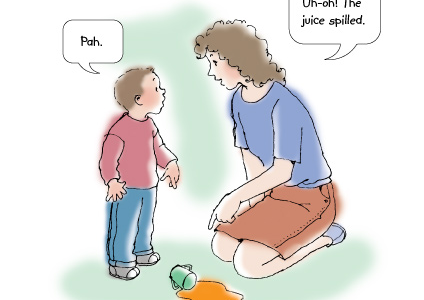
From an early age, parents have a huge impact on their children’s speech and language development. As speech therapists, we get asked all the time: “How do I get my child to talk?” or “What can I do at home to help facilitate talking?” To help parents, Westside has put together a “bag of tricks” to practice at home.
Many times we think that because children are so little that they don’t communicate with us. This is a misconception. Even at birth, children are communicating by laughing, smiling, crying, and making gestures towards parents.
Enhancing your child’s social and communication skills with speech therapy exercises may look like articulation exercises, language intervention, fluency techniques, voice therapy, and assessments. There’s a number of ways you can help promote your child’s development and growth at home during day to day activities. Parents can use the techniques below to begin fostering language development for their children.
Speech & Language Development Ideas for 0-2 Year Olds
(1) Talk and play with your baby as much as you can. Children learn language through play and imitation of others. Say simple sounds like “mama”, “dada,” and “baba.” While children cannot process long sentences, they can process basic commands and words. Engage with your baby and imitate their actions. They will soon learn the meaning of different gestures and movements based on your response. It is important to start the path towards speech and language development early to promote growth and correct communication disorders.
Here are some common ways to productively engage with your baby and promote language development:
Play games with them such as peek-a-boo and or patty cake. This fosters gross and fine motor movements while incorporating speech and language development skills.
Talk to your baby as you bath, feed, and dress them. Talk about what you are doing, where you are going, etc. – all of this helps them learn daily routines.
Point out colors and shapes and count items when you are playing.
Talk about animal sounds; this helps your baby connect the sound and the animal. Use words like “The dog says woof-woof.”
Use an expansion of phrases by adding on to what your baby says. When your baby says, “Mama“, respond with a sentence that expands on that initial vocalization. A good response would be: “Here is Mama. Mama loves you.”
(2) Use the “OWL strategy”- Observe, Wait, Listen. Follow the child’s lead. What a child looks at is what they are interested in, and if they are interested in it, they are more likely to talk about it. Avoid saying “SAY…” Instead, model what you want them to say. Get your child to imitate you. If they imitate your actions, they will learn to imitate your sounds and words!
(3) Read to your child. Choose books that are sturdy and have large colorful pictures. You don’t have to read every word in the book, but talk about the pictures. Ask your child things like “What’s this?” and try to get the child to point to or name objects.
Speech and Language Development Ideas for 2-4 Year Olds
(1) Speak clearly to your child and be a good speech model. Repeat what your child says to show that you understand them. If a child is prompting for juice, you can use words like “Want juice? I have juice. I have apple juice. Do you want apple juice?” Remember, it is okay to use baby talk sometimes, but be sure to use the adult words, too. For example: “It is time for din-din” versus “We will have dinner now”. This will build their fluency techniques and improve over all communication skills.
(2) Help your child understand and ask questions by playing the yes–no game. Ask questions such as, “Are you Jack?” and “Can a pig fly?” Have your child make up questions and try to fool you; this is a fun way to stimulate their brains. Ask questions that include a choice. “Do you want an apple or blueberries?” “Do you want to wear your red shirt or your blue shirt?” Help your child learn new words by naming body parts, and talk about what you do with them. Example: “This is my nose. I can smell flowers, brownies, and soap with it.”
(3) Help your child find the rhythm in speech by singing simple songs and nursery rhymes.
(4) Play the objects-box game. Have your child take an item out of a box of objects and tell you its name and how to use it. This helps them learn what objects are and how to say the name correctly.
(5) Show pictures of familiar people and places and talk about who they are.
For more information check out the following websites from speech and language experts.
- Parent tips for a child who… communicates with words, without words, in sentences, etc.
- http://www.hanen.org/Helpful-Info/Parent-Tips.aspx
- https://www.asha.org/public/speech/development/chart.htm
Empower your child’s social and communication skills through consistent at-home speech therapy exercises. Utilize language intervention techniques, voice therapy sessions, and regular assessments to improve articulation and fluency. These efforts promote effective speech and language development, paving the way for enhanced communication and overall success.
Consider enrolling your child in speech therapy sessions. This can help address communication disorders, teach them fluency techniques, and even voice therapy exercises. Working with a speech pathologist can help your child pick up on language development strategies much faster. Between speech therapy exercises and support at home and in therapy your child will develop much faster.







